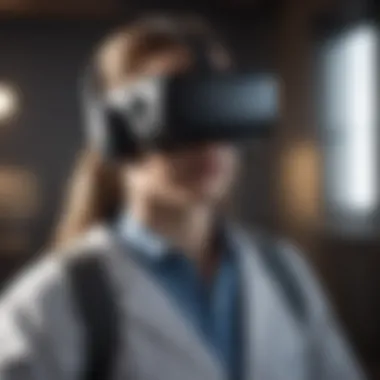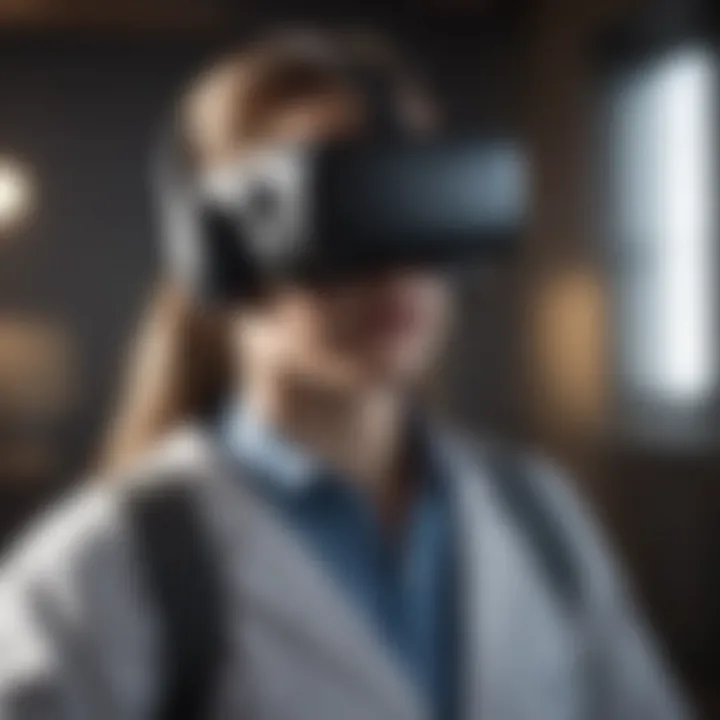Exploring the Impact of Virtual Reality on Higher Education


Intro
In recent years, virtual reality (VR) has emerged as a revolutionary technology, influencing numerous sectors, including healthcare, gaming, and notably, education. The use of VR in higher education presents novel ways of learning and engaging students. By simulating real-world environments, this technology can create immersive educational experiences that traditional methods cannot replicate. As institutions seek to improve student engagement and outcomes, understanding the implications of VR in academic settings is paramount.
Key Concepts
Definition of Primary Terms
To grasp the impact of virtual reality in higher education, it is essential to define several key terms:
- Virtual Reality (VR): A computer-generated simulation of a three-dimensional environment, which can be interacted with using special equipment like VR headsets.
- Immersive Learning: A pedagogical approach that seeks to engage students in active learning by placing them in realistic scenarios or environments.
- Simulation: A representation of a real-world process or system, often used in educational contexts to replicate scenarios for training purposes.
Related Concepts and Theories
The integration of VR into education can be better understood through several educational theories:
- Constructivist Learning Theory: This theory posits that knowledge is constructed through interaction with the environment. VR supports constructivist approaches by providing realistic environments where students can learn through experience.
- Experiential Learning Theory: This framework emphasizes learning through experience, stressing the importance of active involvement. VR offers unique opportunities for experiential learning, creating engagement and fostering deeper understanding.
Future Directions
Gaps Identified in Current Research
While the potential benefits of VR in higher education are widely recognized, substantial gaps in research remain. One significant gap is the long-term effectiveness of VR-enhanced learning compared to traditional methods. There is also a need for studies focusing on diverse disciplines and their unique requirements for VR applications.
Suggestions for Further Studies
Future studies should explore:
- User Experience: Investigating how students engage with VR tools across various learning environments.
- Cost-Benefit Analyses: Evaluating the economic implications of implementing VR in educational settings, considering both initial outlay and long-term gains in student success.
- Ethical Implications: Researching student privacy and data security issues involved in the integration of VR technology in educational contexts.
"Virtual reality is not just a tool; it represents a rethinking of how educational content is delivered and consumed."
For further insights into virtual reality and its implications, consider visiting Wikipedia and Britannica, which provide comprehensive overviews and deep dives into technological advancements.
Prologue
The integration of virtual reality (VR) into higher education represents a significant shift in the way we approach teaching and learning. This topic is increasingly important as educational institutions look for innovative ways to engage students and enhance their learning experiences. The presence of VR in educational settings opens new avenues for exploration, making complex concepts more accessible and interactive.
Virtual reality provides unique learning opportunities by creating immersive environments where students can engage actively with the material. The potential benefits are considerable, ranging from increased engagement to improved retention of information. Furthermore, VR technology allows for tailored experiences that cater to individual learning preferences, thus supporting diverse educational needs.
Implementing VR in higher education does come with considerations. Institutions must navigate the technical requirements, costs, and the need for trained faculty to effectively utilize the technology. Understanding these elements is crucial for successful integration.
In sum, this article aims to explore the impact of VR on higher education, offering a comprehensive analysis of its applications, benefits, and challenges. By diving into this rich topic, educators and policymakers can gain valuable insights that inform their decisions regarding the adoption of VR technologies.
The Evolution of VR Technology
The evolution of virtual reality (VR) technology plays a vital role in better understanding its current application and future potential in higher education. As academic institutions seek effective methods to enhance teaching, learning, and research, recognizing the historical milestones of VR offers insights into its transformative impact. This section elaborates on the dynamics of VR technology, from its inception to present advancements.
Historical Background
Virtual reality's roots trace back to the 1960s when computer scientist Ivan Sutherland developed the first head-mounted display. The term "virtual reality" itself emerged in the 1980s. During this period, the first commercial VR systems, such as the VPL Research’s DataGlove and EyePhone, gained attention.
These initial experiments were limited due to high costs and technical constraints. However, they laid the groundwork for future developments. The 1990s saw a peak in interest with attempts at VR adoption in gaming and education; yet, high prices and lack of content hampered sustained growth.
The turn of the century brought new energy thanks to technological advances in computing and graphics, as well as more affordable hardware. VR has experienced a resurgence in recent years fueled by improved consumer technology and academic interest, making it more accessible for integration into various educational contexts.
Recent Advancements in VR


As we navigate into the 21st century, VR is becoming increasingly sophisticated. Understanding these advancements is crucial to assessing their applicability in the educational sector.
Improved Hardware
Improved hardware has significantly contributed to the immersive nature of VR experiences. Advances in headsets, such as the Oculus Quest and HTC Vive, now provide high-definition visuals and reduced latency. A key characteristic of these devices includes their wireless capabilities, allowing users to move freely without cumbersome cords. This enhancement results in a more natural interaction with virtual environments.
Moreover, built-in sensors and enhanced tracking systems enable more accurate imitation of real-world movements. Such features offer students an engrossing experience in simulations and virtual environments, crucial for fields like architecture or medicine. The accessibility of such hardware makes it a popular choice in educational settings.
Software Innovations
Software innovations are equally important, as they define the virtual experiences users encounter. Programs like Unity and Unreal Engine have democratized VR content creation, making it easier for educators and developers to create tailored applications for specific academic needs.
These platforms enable rich graphics and interactive simulations, enhancing learning experiences in a range of subjects. A key feature of these innovations is their cross-platform compatibility, allowing institutions to leverage various devices for diverse learning environments. While the multitude of software options presents challenges related to quality and learner experience, the potential for custom solutions is substantial, reinforcing VR's relevance in education.
Applications of VR in Higher Education
Virtual Reality (VR) has emerged as a powerful tool in the realm of higher education, offering a wide array of applications that enhance learning experiences. These applications are significant not just for their innovative nature, but for their potential to cater to diverse educational needs. By engaging students in immersive environments, VR encourages active participation, which can lead to deeper understanding and retention of knowledge. Additionally, this technology addresses various learning styles, catering to visual, kinesthetic, and auditory learners alike.
Immersive Learning Environments
The creation of immersive learning environments through VR enables students to engage directly with the educational material. These environments simulate real-world scenarios, allowing students to explore concepts in depth. For instance, a biology class can utilize VR to simulate cellular processes in a 3D space, making abstract concepts more tangible. This method fosters a stronger connection to the material through experiential learning.
Moreover, immersive learning expands beyond traditional classroom boundaries. Students can visit historical sites, experience geographical phenomena, or even engage in virtual laboratories without leaving their campus. Such an approach not only enhances engagement but also stimulates curiosity and motivation in students. It immerses them in their studies, leading to robust educational experiences that are challenging to replicate through standard instructional methods.
Simulations and Training
VR also plays an essential role in simulations and training, particularly in fields such as medicine and engineering. These simulations provide realistic training environments that mirror practical scenarios, offering students valuable experiences without the risks associated with real-life training.
Medical Training
Medical training is one of the areas where VR shines. This application allows students to practice surgical procedures in a safe, controlled environment. A key characteristic of medical training through VR is its ability to provide hands-on experience. Students can learn techniques and protocols without the risk of harming patients. A notable feature is the ability to repeat procedures multiple times, which enables mastery of skills before actual patient contact.
Additionally, VR can present various medical scenarios, allowing students to navigate through complex cases, enhancing critical thinking and decision-making abilities. However, while this method offers numerous advantages, it also comes with limitations. The high costs of developing and updating VR training programs can be a barrier for some institutions, limiting access and scalability.
Engineering Simulations
Engineering simulations also benefit significantly from VR technology. This application enables students to design, analyze, and test their projects in a three-dimensional space. A prominent characteristic of engineering simulations is their capacity to visualize complex structures and systems dynamically. This immersive visualization assists students in understanding spatial relationships and mechanical principles in a practical setting.
The unique feature of engineering VR is its collaborative potential. Multiple students can work on a project within the same VR environment, engaging in real-time problem-solving and design modifications. Despite these benefits, challenges exist, such as technical glitches and the steep learning curve associated with using advanced VR software.
Virtual Field Trips
Lastly, virtual field trips provide an innovative way for students to explore various environments and cultures without geographical limitations. Through VR, they can experience museum exhibits, archaeological sites, or even extensive landscapes. Such virtual excursions cultivate a broader understanding of subject matter and encourage global awareness.
Benefits of VR in Education
Virtual reality (VR) offers numerous advantages in the realm of education, significantly enhancing the learning experience for students. The integration of VR into higher education provides a unique opportunity for students to engage with material in a way that traditional methods often cannot replicate. This section discusses the specific benefits of VR in education, including enhanced engagement, improved retention rates, and support for diverse learning styles. Each of these elements contributes to a richer and more effective learning environment.
Enhanced Engagement
One of the primary benefits of VR in education is its ability to enhance student engagement. Engaging students is critical for effective learning, as students who are actively involved in their education tend to perform better. VR creates immersive environments where students can interact with content in real-time. This level of interactivity often leads to deeper involvement in the subject matter.
For example, a biology class might use VR to explore the human body in a three-dimensional space. This experience allows students to visualize structures and systems that would be difficult to understand from textbooks alone. The element of exploration encourages curiosity and motivates students to learn more. Moreover, VR facilitates collaborative learning, as students can work together in virtual settings, discussing ideas and solving problems collectively.
Improved Retention Rates
Research indicates that the use of VR can lead to improved retention rates among students. When learners are exposed to new material in an engaging and interactive way, they are more likely to remember the information long-term. This phenomenon can be attributed to the brain's enhanced ability to process and store experiences that involve active participation.
Incorporating VR into curricula also allows for repetition in a dynamic format without the monotony that can occur with traditional study methods. A nursing student, for example, who practices patient care in a virtual emergency room setting, is more likely to recall procedures and protocols due to their hands-on practice in a relevant and realistic context. Such experiential learning is proven to reinforce memory and skills.


Support for Diverse Learning Styles
Another notable advantage of VR in education is its ability to support various learning styles. Not every student learns the same way. Some students benefit from visual aids, whilst others may prefer hands-on activities or auditory instructions. By offering a multi-faceted approach to learning through VR, educators can cater to the unique preferences of their students.
Virtual reality allows students to learn visually through simulations, audibly through narrated guides, and kinesthetically through interactive exercises. For instance, in fields such as engineering or architecture, students can manipulate objects in a 3D environment, combining visual and tactile learning in a manner that is often impossible in a traditional classroom. This promotion of inclusivity ensures that all students have the opportunity to engage with the content in a manner that resonates with their individual learning needs.
"VR technologies transform the educational landscape by fostering a classroom environment tailored to varying student needs while promoting higher levels of participation and retention."
In summary, the benefits of VR in education are profound. Enhanced engagement, improved retention rates, and support for diverse learning styles all contribute to a more effective and enriching educational experience. As more institutions consider integrating these technologies, the potential for transforming higher education grows.
Challenges in Implementing VR
Adopting virtual reality in higher education carries significant challenges. These hurdles can limit the enthusiasm and willingness of institutions to integrate VR technology into their curricula. Understanding the complexities around these challenges is vital for educators, administrators, and policymakers. With this knowledge, they can make informed decisions that optimize the implementation of VR, ultimately enhancing the educational experience.
Cost Implications
One of the primary barriers to VR implementation is cost. The equipment required for effective virtual reality experiences can be expensive. High-performance computers, VR headsets, and peripheral devices accumulate quickly and strain tight budgets of many educational institutions.
Moreover, ongoing costs present a further complication. Software licensing fees, maintenance of hardware, and updates can lead to additional financial burdens. Schools must weigh these costs against the potential benefits. Though VR can enhance learning, the immediate financial implications can deter institutions from making the leap towards immersive education.
Additionally, not all programs in VR education yield equal quality. Some require substantial investments for high-quality content immersion. Institutions might need to partner with tech companies or developers that specialize in educational VR. This process can add to the structural costs and complicate budgeting further.
Technical Limitations
The technical challenges of VR go beyond mere hardware. Institutions often face issues related to the compatibility of software and existing infrastructure. For effective VR experiences, significant upgrades may need to happen. In many cases, more powerful data processing machines and upgraded networks are required to handle the demands of VR applications.
There are also concerns about the reliability and accessibility of VR technology. Institutions must ensure that all students can access the necessary devices and that those devices are functioning correctly. Technical glitches during lessons can be frustrating and impact student learning. If VR fails to deliver consistently, it can erode confidence in the technology among faculty and students alike.
Faculty Training Requirements
Successful VR integration demands that faculty members be familiar with the technology. Many educators lack training in using VR tools effectively within their courses. When teachers are not prepared, they may be reluctant to employ VR, missing out on opportunities for enhanced learning experiences.
Training programs must be developed to equip faculty with the necessary skills. This educational approach adds another layer of complexity to implementation. Time constraints can further limit this training, as educators often juggle heavy teaching loads and responsibilities. Without adequate and ongoing professional development, faculty members may struggle to incorporate VR in a meaningful way.
"Training educators in using VR effectively is not just beneficial; it is essential for achieving the potential of this technology in higher education."
In summation, the challenges of implementing VR in higher education are multifaceted. From financial concerns to technical hurdles and the need for faculty training, institutions must address these issues with a strategic approach. By understanding these challenges, it is possible to devise solutions to foster the integration of VR technologies, enriching the educational landscape.
Ethical Considerations
As virtual reality (VR) becomes more integrated into higher education, it is essential to address the ethical considerations surrounding its use. This topic encompasses various aspects that influence both students and institutions. Understanding these implications can ensure that educators implement VR in a manner that promotes fairness, privacy, and educational integrity.
Data Privacy Issues
One significant concern regarding the integration of VR in education is data privacy. When students use VR technologies, they often generate a wealth of data. This data can include personal information, physical responses, and behavioral patterns. Educational institutions must prioritize the protection of this data.
Failure to safeguard this sensitive information can lead to unauthorized access and breaches. Institutions need to adopt strict policies to manage data collection, storage, and usage. Additionally, informing students about how their data will be utilized adds a layer of transparency, fostering trust between students and the institution.
"Protecting student data is not just a legal obligation, but a moral one as well."
Equity of Access
Equity of access is another important consideration when implementing VR in higher education. Not all students have the same access to the technology required for immersive learning experiences. Financial constraints and geographical limitations can inhibit some students from participating fully in VR-enhanced courses.
To address these disparities, institutions should develop strategies to provide equitable access to VR resources. This can include offering subsidized devices, providing VR labs on campus, or partnering with community organizations.
Moreover, institutions must consider different learning environments. For instance, online courses should incorporate VR experiences that are accessible to all students, regardless of their location. Ensuring that every student has the opportunity to engage with VR technologies will ultimately enhance the educational landscape, promoting inclusivity and diversity.
Case Studies of VR in Higher Education


In the context of this article, the examination of case studies related to the implementation of virtual reality in higher education is crucial. These case studies serve not only as examples but also as benchmarks for understanding both the effectiveness and challenges of VR technology in academic environments. Through these concrete examples, one can grasp how VR transforms traditional learning into immersive experiences.
Successful Implementations
Examples from Various Institutions
Various educational institutions have adopted virtual reality in notable ways. The use of VR in classrooms is exemplified by initiatives at places like Stanford University, where they utilize virtual environments for medical students to practice procedures in a risk-free setting. This hands-on experience is significant because it blends theoretical knowledge with practical application.
According to reports, institutions like the University of Illinois have also integrated VR in their teaching methodologies. Their geology courses use VR for virtual field trips, allowing students to explore geological formations that would be difficult to visit in person. This unique feature enhances student engagement, often leading to deeper understanding of complex subjects.
The choice of such implementations stems from VR's ability to clarify abstract concepts through visualization. With immersive experiences, students can interact meaningfully with their environment, thus becoming more involved in their learning. The accessibility of technology like Oculus Rift makes this increasingly achievable.
Student Outcomes
In regards to student outcomes, research indicates that employing VR in learning environments has a significant impact on performance and retention. Schools that have embraced VR often report higher levels of satisfaction and comprehension among students. For instance, studies show that students participating in VR-enabled courses at institutions like the University of Florida outperform their peers in traditional settings.
A key characteristic of these outcomes is the improved retention rates observed in students. Virtual reality caters to a more diverse range of learning preferences, effectively addressing the needs of visual and kinesthetic learners. The unique aspect of VR is its capability to immerse users fully, allowing for experiential learning that sticks in memory longer than passive forms of education.
"VR can turn learning into an experience rather than a task, fundamentally changing the educational landscape."
However, one must consider potential drawbacks. Not all students may have equal access to VR technologies due to financial constraints or availability. Such disparities can create challenges in achieving equitable educational experiences. Thus, while positive outcomes exist, they come with the necessity for careful planning and resource allocation.
Lessons Learned
As multiple institutions navigate the challenges and benefits of integrating virtual reality into their curricula, several key lessons emerge. First, institutions should prioritize faculty training to ensure that educators are comfortable and proficient with VR tools. Investment in training can significantly influence the effectiveness of VR applications in the classroom. Additionally, ongoing assessments of student engagement and learning outcomes must guide future decisions regarding VR integration. This data-driven approach will facilitate continuous improvement and adaptation of VR technologies.
Future Directions of VR in Education
As we look at the horizon of virtual reality in education, it is crucial to consider how this technology will evolve and the implications for future learning experiences. The direction VR takes in academia can define how students interact with information, collaborate, and comprehend complex concepts. With an increased integration of VR technology into curricula, it is essential to explore the specific elements driving this change, the benefits offered, and considerations that educators and institutions should take into account.
Emerging Trends
Several emerging trends indicate how VR could transform the educational landscape further. One notable trend is the rise of collaborative immersive environments. Such spaces allow students from different locations to interact and learn together virtually. This fosters teamwork and communication skills essential in today’s globalized world.
Another trend is the incorporation of gamification in educational VR. Learning modules designed like games can motivate students to engage more deeply with content. For example, platforms that offer challenges and rewards for achieving specific educational goals can increase learner satisfaction and retention rates.
Additionally, advancements in artificial intelligence are making personalized VR experiences more achievable. Tailoring educational content to individual learning paces and styles can significantly enhance effectiveness. By adapting scenarios to meet the unique needs of each student, VR can address gaps in knowledge and accommodate diverse learners efficiently.
Finally, as VR technology becomes more affordable and accessible, an increasing number of institutions are likely to adopt it. This trend will democratize access to high-quality, immersive educational experiences.
Potential Research Areas
Identifying potential research areas in VR for education is vital for guiding future studies and developments. Here are some suggestions:
- Measuring Impact: More comprehensive studies are needed to evaluate the effectiveness of VR in enhancing learning outcomes. Research can focus on diverse student populations to understand its full potential.
- Development of Content: Investigating best practices for developing VR content tailored to specific disciplines would be beneficial. Collaboration between educators, developers, and researchers can lead to more effective learning tools.
- Long-term Engagement: Researching how VR impacts student retention over the long term can provide insights into its sustainability as an educational tool. Understanding how immersive experiences affect motivation is a key area that deserves attention.
- Integration Strategies: Exploring strategies for integrating VR into existing curricula is crucial. Research can identify potential barriers to adoption and propose frameworks for incorporating VR seamlessly into traditional teaching methods.
- Ethical Considerations: As VR becomes more prevalent, it’s important to examine ethical considerations, including data privacy and the potential for equity gaps. Research in this area will help ensure that VR is used responsibly and inclusively.
"The evolution of VR in education is not just about technology—it's about rethinking how we deliver knowledge in a meaningful way."
Each of these areas holds the potential for significant contributions to the field and can aid in shaping the future of virtual reality in educational systems. By focusing on these emerging trends and research domains, stakeholders can ensure that VR is not just a fad but a transformative force in higher education.
Ending
The topic of this article is fundamental in understanding the evolving landscape of education. Virtual reality (VR) offers unique opportunities that can significantly enhance learning. It breaks the confines of traditional learning environments, inviting interactions that are more engaging. This shift has implications not just for students but also for educators and institutions, requiring a reevaluation of pedagogical strategies.
Summarizing Key Points
VR’s potential transformation of higher education encompasses various facets. Here are the critical points discussed in this article:
- Applications of VR: From immersive learning environments to simulations for real-world training, VR showcases its versatility across disciplines.
- Benefits: Enhanced engagement and improved retention rates indicate that students often learn better in VR settings. It also supports diverse learning styles, catering to a broader audience.
- Challenges: High costs and technical limitations pose real barriers. Additionally, training of faculty members is essential to utilize the technology effectively.
- Ethical Considerations: Data privacy and equity of access remain pressing issues that need to be addressed to create an inclusive education system.
- Future Directions: Emerging trends and several research areas indicate that VR’s role in education is only beginning to be understood, suggesting further exploration and innovation in this field.
Call for Further Exploration
More investigation into VR in higher education is crucial. As institutions start integrating VR, they should explore:
- Effectiveness of VR: While initial studies show promise, long-term effectiveness and its impact on various learning methodologies should be closely monitored.
- User Experiences: Understanding the student experience in VR settings can guide improvements. Collecting qualitative data can help adjust applications to better fit educational needs.
- Policy Development: As VR in education becomes mainstream, policies must evolve. Institutions should advocate for guidelines that ensure equity and fairness in access to new technologies.



